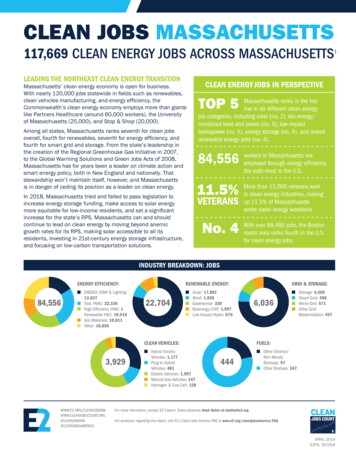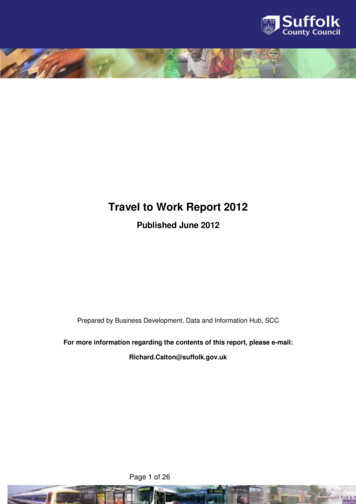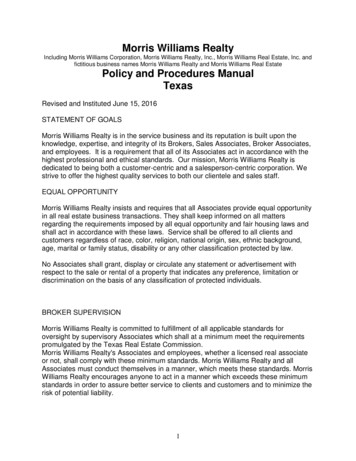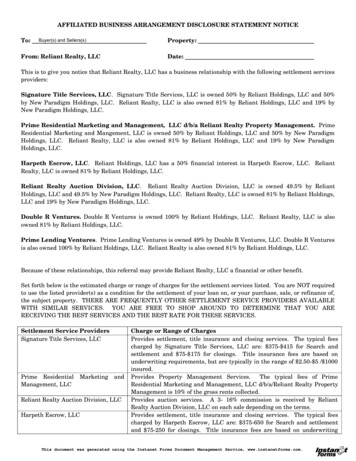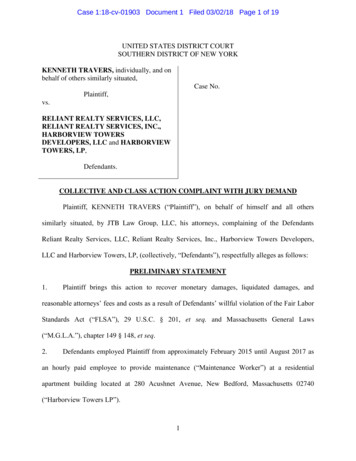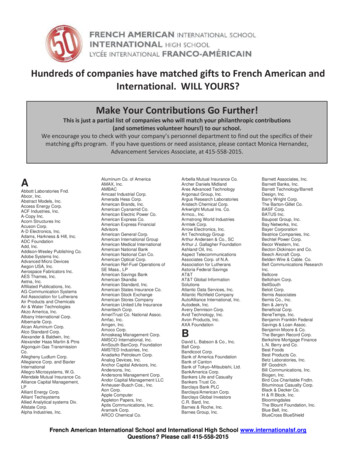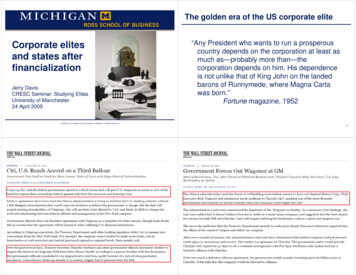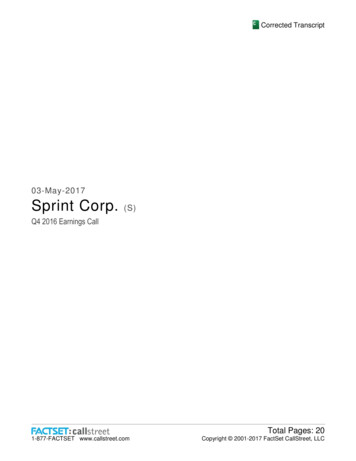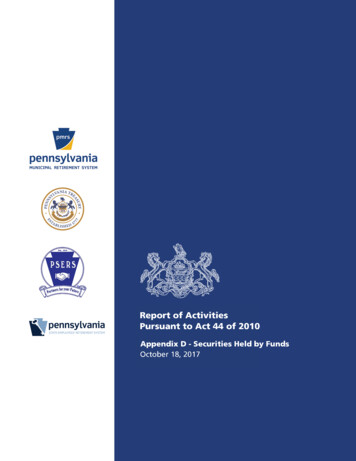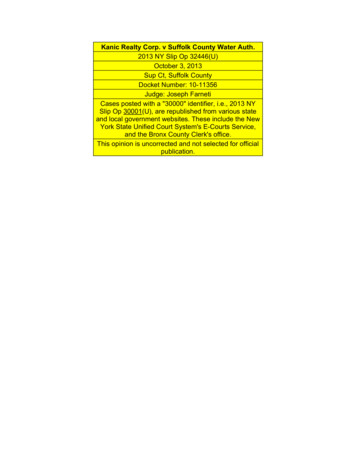
Transcription
Kanic Realty Corp. v Suffolk County Water Auth.2013 NY Slip Op 32446(U)October 3, 2013Sup Ct, Suffolk CountyDocket Number: 10-11356Judge: Joseph FarnetiCases posted with a "30000" identifier, i.e., 2013 NYSlip Op 30001(U), are republished from various stateand local government websites. These include the NewYork State Unified Court System's E-Courts Service,and the Bronx County Clerk's office.This opinion is uncorrected and not selected for officialpublication.
[* 1]COPYSHORT FORM ORDERINDEX No. 10-11356SUPREME COURT- STATE OF NEW YORKI.A.S. PART 37 - SUFFOLK COUNTYPRESENT:Hon.JOSEPH F ARNET!Acting Justice Supreme CourtMOTION DATE ---'l""""0-"-3'-'-1 2 .(#'-'--'0'-"-0.:;.15) MOTION DATE 11-28-12 (#006)ADJ. DATE5-9-13Mot. Seq.# 005 - MD# ------------------------XKANIC REALTY CORP.,Plaintiff,DAVID I. ABOULAFIA, ESQ.Attorney for Plaintiff60 East 42nd Street, Suite 2231New York, New York 10165- against SUFFOLK COUNTY WATER AUTHORITY,Defendant.SHEARER & DWYER LLPAttorney for Defendant1581 Franklin AvenueMineola, New York -------------------)(Upon the following papers numbered I to.Ql read on this motion to, inter alia, strike pleadings ; Notice of Motion/Order to Show Cause and supporting papers I - 36 ; Notice of Cross Motion and supporting papers 37 - 53 ; AnsweringAffidavits and supportmg papers 56 - 61 ; Replying Affidavits and supporting papers 64 - 66 ; Other memorandum oflaw,54 - 55, 62 - 63. 64 -65 ; it is,ORDERED that this motion by plaintiff Kanic Realty Corp. for, inter alia, an Order strikingdefendant's answer under CPLR 3126 and for partial summary judgment on the issue of liability isdenied; and it is furtherORDERED that this cross-motion by defendant Suffolk County Water Authority for, inter alia,summary judgmen1 dismissing plaintiffs causes of action for private and public nuisance and for anOrder amending a So-Ordered Stipulation is determined as follows.On January 23, 2009, a building on premises known as 29 Little Neck Road, Centerport, which isowned by plaintiff Kanic Realty Corp., became inundated with water following multiple sprinkler pipebreaks that occurred throughout the building. The complaint alleges that the breaks in the sprinklerpipes were caused by a surge of water pressure emanating from the equipment, water lines, pipes andplants owned by defendant Suffolk County Water Authority ("SCWA"). The complaint also assertscauses of action for public and private nuisance.Plaintiff now moves for an Order striking SCWA's answer or precluding it from submittingproof denying that it was on notice of the condition that proximately caused the property damage.
[* 2]Kanic Realty v SCWAIndex No. 10-11356Page No. 2Specifically, plaintiff contends that defendant's intentional delay and failure to comply with demands toidentify and produce for deposition a witness named Robert Wilbur has prejudiced plaintiff, as Mr.Wilbur has moved out of state and is unavailable to plaintiff. Alternatively, plaintiff seeks an Ordergranting partial summary judgment in its favor on the issue ofliability. In support of its motion, plaintiffsubmits, among other things, a copy of the pleadings; affidavits of William Seevers, Roger Piacentini,and Albert Machlin; transcripts of the deposition testimony of Nicole Bubo lo and Paul Kuzman;computer printouts of service orders by SCWA pertaining to the subject premises; and correspondencebetween the parties' counsel.Defendant opposes the motion and cross-moves for partial summary judgment dismissingplaintiffs causes of action for private nuisance and public nuisance. Defendant also seeks an Orderamending a So-Ordered Conference Stipulation/Order to reflect the correct date of such Order, anddirecting the issuance of an Open Commission in the State of North Carolina pursuant to CPLR 3108and 3111. In suppmt of its cross-motion, defendant submits, among other things, an affidavit and reportof Russell Fleming, a report from the Fire Marshal regarding the subject incident, computer printouts ofits service orders pertaining to the subject premises, and excerpts of the transcripts of the depositiontestimony of Katherine Bubo lo and Paul Kuzman. Plaintiff opposes defendant's application forsummary judgment on the causes of action for private and public nuisance.William Seevers, an environmental hydrologist, states in his expert affidavit that he inspected thesubject premises on February 24 and March 29, 2012 with his partner, Albert Machlin. He states that onhis first visit, he observed severe water damage and ruptured cast iron sprinkler lines throughout thehome, and that the most severe damage to piping was found on the upper levels of the house. He opinesthat such damage is unlikely where there have been any "freeze-up" conditions, because heat rises, andthe damage from freezing is most often more severe on lower levels. Seevers states that during hissecond visit, he observed very little damage to piping in the basement, which is generally where morepipe damage would occur in a "freeze-up" situation. Seevers states that he observed damage tosheetrock and wall covering at places where fire line piping passed through walls from room to room,which is consistent with pipe movement caused by surges in pressure or flow. He also states that heobserved a water pressure reducing device installed on the premises and opined that the failure of the 50pound pressure reducer to prevent the casualty indicates massive pressure in the fire line. He states thatbased on the temperature on the day of the incident, with a minimum of 24 degrees and a maximum of28.5 degrees, pipe freezing generally does not occur. He explains that the threshold temperature forplumbing freeze-ups is 20 degrees according to the Building Research Council at the University ofIllinois. He concludes that breaks in the piping were caused by pressure surges of the sort that wereinvestigated by the SCWA, rather than by freezing.Albert Machlin, a registered professional engineer, states in his expert affidavit that there are anumber of pumping stations feeding the subject premises, including the Meade pump station located lessthan half a mile from the premises. He states that well pumps are "centrifugal pumps with a specificcharacteristic curves, which result in an initial high pressure spikes when turned on." He explains thathigh pressure surges are more likely to affect homes in close proximity to a pumping station and thatthese surges can cause pipes to rattle as well as rupture. He states that the damage in the piping at the
[* 3]Kanic Realty v SCWALndex No. 10-11356Page No. 3premises appeared confined to the sprinkler piping, making any other cause for the rupture other than apressure surge unlikely. He concludes that the likely cause of the pipe breakage was a spike in waterpressure from the operation of the centrifugal pumps where the water originated. He further states that ifthe fire water valve had been shut off by the SCWA before the subject incident, the pressure in the "mainwould not have impacted the sprinkler system and the only water that would have been released into thehouse would have been water stored in the sprinkler pipes instead of the huge amounts of water thatcontinuously flowed under pressure into the house."Russell Fleming, an engineer, states in his expert affidavit that he conducted a forensicexamination of the subject premises on August 12, 2010. He opines that the break in the pipes occurredas a result of freezing of the sprinkler system due to lack of sufficient heat, not because of elevated waterpressure supplied by SCWA. He states that under the provisions of the New York State Fire Code, abuilding owner is responsible for properly maintaining a fire sprinkler system, and the Code providesthat part of the maintenance responsibility is ensuring all water-filled piping is maintained at a minimumtemperature of 40 degrees.At her examination before trial, Nicole Bubolo testified that she was living at the subjectpremises with her husband and a friend at the time of the incident. She testified that her parents,Katherine and Nicholas Bubolo, are the principals of Kanic Realty, which owns the subject premises.She testified that the premises, which previously had been used as an adult care facility, has three floorsand an elevator. She testified that prior to the incident, she called SCWA to complain about the sound ofpipes banging behind the walls. She testified that an employee ofSCWA who came to inspect the pipesstated that the water pressure was too high in the house and that the water pressure exceeded what wasconsidered a safe maximum water pressure in the house. Bubolo testified the heat was never turned offin the subject premises.At his examination before trial, Paul Kuzman, Director of Production Control of SCWA, testifiedthat his review of the SCWA's computerized records revealed complaints regarding hammering soundsand pipes banging at the subject premises. He testified an employee of sewA, Robert Wilbur, went toinspect the subject premises prior to the incident. He testified the computerized records indicates that afire line needed to be shut off and that a valve box needed to be repaired at the premises and that thiswas a routine request. He further testified that he does not know whether sewA took steps to mitigatethe water pressure at the premises.Parties to litigation are entitled to "full disclosure of all evidence material and necessary in theprosecution or defense of an action, regardless of the burden of proof' (CPLR 3101 [a]). This provisionhas been liberally construed to require disclosure "of any facts bearing on the controversy which willassist [the parties'] preparation for trial by sharpening the issues and reducing delay and prolixity" (Allenv Crowell-Collier Pub. Co., 21 NY2d 403, 406, 288 NYS2d 449 [ 1968]). "If there is any possibility thatthe information is sought in good faith for possible use as evidence-in-chief or in rebuttal or for crossexamination, it should be considered 'evidence material * * * in the prosecution or defense' "(Allen vCrowell-Collier Pub. Co. , supra, at 407, 288 NYS2d 449, quoting CPLR 3101). Nonetheless, litigantsdo not have carte blanche to demand production of any documents or other tangible items that they
[* 4]Karrie Realty v SCW AIndex No. 10-11356Page No. 4speculate might contain useful information (see Beckles v Kingsbrook Jewish Med. Ctr., 36 AD3d 733,830 NYS2d 203 [2d Dept 2007]; Smith v Moore, 31 AD3d 628, 818 NYS2d 603 [2d Dept 2006]; Vyasv Campbell, 4 AD3d 417, 771 NYS2d 375 [2d Dept 2004]). Thus, a party will not be compelled tocomply with disclosure demands that are unduly burdensome, lack specificity, seek privileged materialor irrelevant infomrntion, or are otherwise improper (see, e.g. Astudillo v St. Francis-Beacon ExtendedCare Facility, 12 AD3d 469, 784 NYS2d 645 [2d Dept 2004]; Bettan v Geico Gen. Ins. Co., 296 AD2d469, 745 NYS2d 545 [2d Dept], lv dismissed 99 NY2d 552, 754 NYS2d 204 [2002]; CrazytownFurniture v Brooklyn Union Gas Co., 150 AD2d 420, 541NYS2d30 [2d Dept 1989]; Herbst v Bruhn,106 AD2d 546, 48.3 NYS2d 363 [2d Dept 1984]).Although actions should be resolved on the merits whenever possible (see Simpson v City ofNew York, 10 AD3d 601, 781NYS2d683 [2d Dept 2004]; Bach v City of New York, 304 AD2d 686,757 NYS2d 759 [2d Dept 2003]; Cruzatti v St. Mary's Hosp., 193 AD2d 579, 597 NYS2d 457 [2d Dept1993 ]), a court may strike a pleading or impose other sanctions against a party who "refuses to obey anorder for disclosure or willfully fails to disclose information which the court finds should have beendisclosed" (CPLR 3126; see Nicolia Ready Mix, Inc. v Fernandes, 37 AD3d 568, 829 NYS2d 704 [2dDept 2007]; Mendez v City of New York, 7 AD3d 766, 778 NYS2d 501 [2d Dept 2004]). The penaltiesauthorized by CPLR 3126 are designed "to prevent a party who has refused to disclose evidence fromaffirmatively exploiting or benefitting from the unavailability of the proof' during a civil action (OakBeach Inn Corp. v Babylon Beacon, 62 NY2d 158, 166, 476 NYS2d 269 [1984]).A party seeking the extreme sanction of striking a pleading and preclusion has the initial burdenof coming forward with evidence clearly showing that the failure to comply with disclosure orders ordiscovery demands was willful, contumacious or in bad faith (see Conciatori v Port Auth. of New York& New Jersey, 46 AD3d 501, 846 NYS2d 659 [2d Dept 2007]; Shapiro v Kurtzman, 32 AD3d 508, 820NYS2d 311 [2d Dept 2006]). Willful and contumacious conduct may be inferred from a party'srepeated failure to respond to discovery demands or to comply with disclosure orders, coupled withinadequate excuses for such default (see Bomzer v Parke-Davis, Div. of Warner Lambert Co., 41 AD3d522, 839 NYS2d 110 [2d Dept 2007]; Powell v Cipollaro, 34 AD3d 551, 824 NYS2d 409 [2d Dept2006]; Devito v J & J Towing, Inc., 17 AD3d 624, 794 NYS2d 74 [2d Dept 2005]).Plaintiffs application for an Order striking the answer and precluding defendant from submittingproof denying that it was on notice of the condition that proximately caused the property damage isdenied absent a clear showing that defendant was willful and contumacious in delaying the disclosure ofcertain witnesses and in failing to produce such witnesses sought by plaintiff (see Polsky v Tuckman, 85AD3d 750, 924 NYS2d 830 [2d Dept 2011]; A.F.C. Enters. v New York City School Constr. Auth., 33AD3d 737, 822 NYS2d 775 [2d Dept 2006]; Pepsico, Inc. v Winterthur Intl. Am. Ins. Co., 24 AD3d742, 806 NYS2d 711 [2d Dept 2005]; cf, Reidel v Ryder TRS, Inc., 13 AD3d 170, 786 NYS2d 4887[1st Dept 2004]). Contrary to plaintiff's assertion, the Order dated April 20, 2011, does not specify adefinite date when Robert Wilbur and Steve Dalton were to be produced for deposition. In addition,plaintiff fails to submit evidence that a notice of deposition was served on defendant.
[* 5]Kanic Realty v SCWAIndex No. 10-11356Page No. 5As to plaintiff's application for partial summary judgment on the issue of liability, a partyseeking summary judgment bears the initial burden of proof and must tender evidence sufficient toeliminate all matenal issues of fact (Winegrad v New York Univ. Med. Ctr., 64 NY2d 851, 487 NYS2d316 [ 1985]). Once the movant meets this burden, the burden then shifts to the opposing party todemonstrate that there are material issues of fact; mere conclusions and unsubstantiated allegations areinsufficient to raise any triable issues of fact (see Zuckerman v City of New York, 49 NY2d 557, 427NYS2d 595 [1980]; Perez v Grace Episcopal Church, 6 AD3d 596, 774 NYS2d 785 [2004]). As thecourt's function on such a motion is to determine whether issues of fact exist, not to resolve issues offact or to determine matters of credibility, the facts alleged by the opposing party and all inferences thatmay be drawn are to be accepted as true (see Roth v Barreto, 289 AD2d 557, 735 NYS2d 197 [2d Dept2001 ]; O'Neill v Fishkill, 134 AD2d 487, 521NYS2d272 [2d Dept 1987]).Here, summary judgment in favor of plaintiff on the issue of liability, is denied. Both partieshave submitted conflicting expert affidavits as to the cause of the pipes breaking, and, thus, thereremains a question of fact as to the cause of the breakage (see Cregan v Sachs, 65 AD3d 101, 879NYS2d 440 [1st Dept 2009]; Gleeson-Casey v Otis Elevator Co., 268 AD2d 406, 702 NYS2d 321 [2dDept 2000]).With regard to defendant's cross-motion for summary judgment on the causes of action forpublic and private nuisance, to recover damages based on the tort of private nuisance, a plaintiff mustestablish an interference with his or her right to use and enjoy land, substantial in nature, intentional ornegligent in origin, unreasonable in character, and caused by the defendant's conduct (see Copart Indus.v Consolidated Edison Co. of N.Y., 41NY2d564, 394 NYS2d 169 [1977]). Discomfort andinconvenience caused by the disturbance of property are valid grounds for recovery in an action fornuisance (see Dixon v New York Trap Rock Corp., 293 NY 509, 58 NE2d 517 [1944]). To constitute anuisance, the use must be such as to produce a tangible and appreciable injury to neighboring property orto render its enjoyment specially uncomfortable or inconvenient (see Copart Indus. v ConsolidatedEdison Co. of N. Y. supra). A cause of action to abate a public nuisance "exists for conduct thatamounts to a substantial interference with the exercise of the common right of the public, therebyoffending public morals, interfering with the use by the public of a public place or endangering orinjuring the property, health, safety or comfort of a considerable number of persons" (532 Madison Ave.Gourmet Foods v Finlandia Ctr., 96 NY2d 280, 292, 727 NYS2d 49 [2001]). A public nuisance isconsidered a violation against the State, and is actionable by a private person only if it is demonstratedthat the person seeking relief suffered special injury beyond that suffered by the community at large (532Madison Ave. Gourmet Foods v Finlandia Ctr., 96 NY2d 280, 292, 727 NYS2d 49; see Matter ofAgoglia v Benepe, 84 AD3d 1072, 924 NYS2d 428 [2d Dept 2011]).Here, defendant has failed to establish its prima facie entitlement to summary judgment as amatter of law as to the causes of action for public and private nuisance. Defendant asserts that plaintiffis "incapable of pointing to any testimony" by any witness which supports intentional and unreasonableactions by defendant with respect to the bursting of the water pipes in plaintiffs premises. However, adefendant cannot obtain summary judgment by pointing to gaps in plaintiffs proof; rather, it mustadduce affirmative evidence that its actions were not intentional and unreasonable (see Vittorio v U-
[* 6]Kanic Realty v SCWAIndex No. 10-11356Page No. 6Haul Co., 52 AD3d 823, 861 NYS2d 726 [2d Dept 2008]; Pappalardo v Long ls. R.R. Co., 36 AD3d878, 829 NYS2d 173 [2d Dept 2007]). Accordingly, defendant's cross-motion for summary judgment asto the aforementioned causes of action is denied.With regard to defendant's application for an Order, pursuant to CPLR 3108 and CPLR 3111,directing the issuance of an open commission enabling defendant to issue a subpoena for the depositionof nonparty witness, Robert Wilbur, under the circumstances, defendant's request to subpoena Mr.Wilbur for a deposition is appropriate (see Kekis v Park Slope Emergency Physician Serv., 244 AD2d463, 664 NYS2d 609 [2d Dept 1997]; Goldblatt v Avis Rent A Car Sys., 223 AD2d 670, 637 NYS2d188 [2d Dept 1996]; Stanzione v Consumer Bldrs., 149 AD2d 682, 540 NYS2d 482 [2d Dept 1989];Wiseman v American Motor Sales Corp., 103 AD2d 230, 479 NYS2d 528 [2d Dept 1984]). However,the motion for an open commission must be denied at this time, as defendant failed to establish whichcourt in North Carolina has the appropriate jurisdiction to receive the commission and issue a subpoenato Mr. Wilbur directing him to appear for a deposition.Lastly, defendant's unopposed application for an Order amending the So-Ordered ConferenceStipulation/Order dated April 20, 2010, referenced in the affirmation to reflect the date of April 20,2011, is granted, as a search of the Court's computerized records confirm that April 20, 2011 is the datesuch conference was held.Dated: October 3, 2013. J seph Fametiting Justice Supreme CourtFINAL DISPOSITIONXNON-FINAL DISPOSITION
Kanic Realty Corp. v Suffolk County Water Auth. 2013 NY Slip Op 32446(U) October 3, 2013 Sup Ct, Suffolk County . directing the issuance of an Open Commission in the State of North Carolina pursuant to CPLR 3108 and 3111. In suppmt of its cross-motion, defendant submits, among other things, an affidavit and report . plumbing freeze-ups is .
